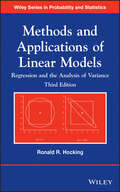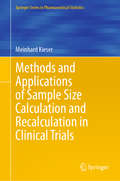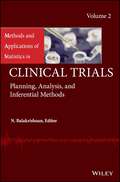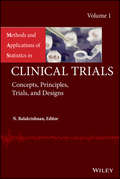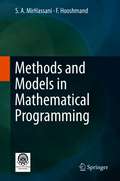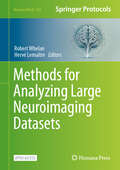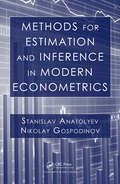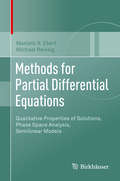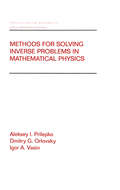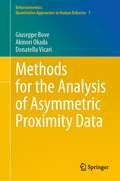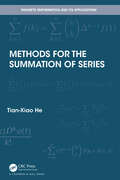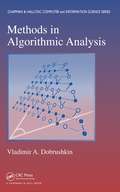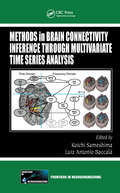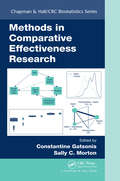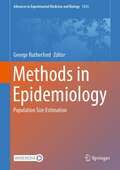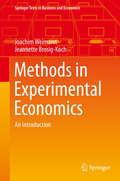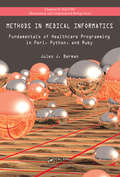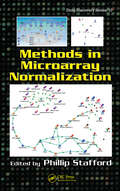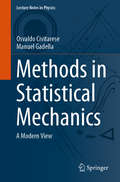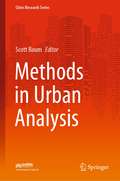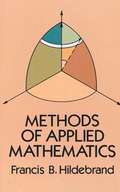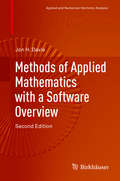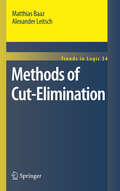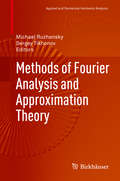- Table View
- List View
Methods and Applications of Linear Models
by Ronald R. HockingPraise for the Second Edition"An essential desktop reference book . . . it should definitely be on your bookshelf." --TechnometricsA thoroughly updated book, Methods and Applications of Linear Models: Regression and the Analysis of Variance, Third Edition features innovative approaches to understanding and working with models and theory of linear regression. The Third Edition provides readers with the necessary theoretical concepts, which are presented using intuitive ideas rather than complicated proofs, to describe the inference that is appropriate for the methods being discussed.The book presents a unique discussion that combines coverage of mathematical theory of linear models with analysis of variance models, providing readers with a comprehensive understanding of both the theoretical and technical aspects of linear models. With a new focus on fixed effects models, Methods and Applications of Linear Models: Regression and the Analysis of Variance, Third Edition also features:Newly added topics including least squares, the cell means model, and graphical inspection of data in the AVE methodFrequent conceptual and numerical examples for clarifying the statistical analyses and demonstrating potential pitfallsGraphics and computations developed using JMP® software to accompany the concepts and techniques presentedNumerous exercises presented to test readers and deepen their understanding of the materialAn ideal book for courses on linear models and linear regression at the undergraduate and graduate levels, the Third Edition of Methods and Applications of Linear Models: Regression and the Analysis of Variance is also a valuable reference for applied statisticians and researchers who utilize linear model methodology.
Methods and Applications of Sample Size Calculation and Recalculation in Clinical Trials (Springer Series in Pharmaceutical Statistics)
by Meinhard KieserThis book provides an extensive overview of the principles and methods of sample size calculation and recalculation in clinical trials. Appropriate calculation of the required sample size is crucial for the success of clinical trials. At the same time, a sample size that is too small or too large is problematic due to ethical, scientific, and economic reasons. Therefore, state-of-the art methods are required when planning clinical trials. Part I describes a general framework for deriving sample size calculation procedures. This enables an understanding of the common principles underlying the numerous methods presented in the following chapters. Part II addresses the fixed sample size design, where the required sample size is determined in the planning stage and is not changed afterwards. It covers sample size calculation methods for superiority, non-inferiority, and equivalence trials, as well as comparisons between two and more than two groups. A wide range of further topics is discussed, including sample size calculation for multiple comparisons, safety assessment, and multi-regional trials. There is often some uncertainty about the assumptions to be made when calculating the sample size upfront. Part III presents methods that allow to modify the initially specified sample size based on new information that becomes available during the ongoing trial. Blinded sample size recalculation procedures for internal pilot study designs are considered, as well as methods for sample size reassessment in adaptive designs that use unblinded data from interim analyses. The application is illustrated using numerous clinical trial examples, and software code implementing the methods is provided. The book offers theoretical background and practical advice for biostatisticians and clinicians from the pharmaceutical industry and academia who are involved in clinical trials. Covering basic as well as more advanced and recently developed methods, it is suitable for beginners, experienced applied statisticians, and practitioners. To gain maximum benefit, readers should be familiar with introductory statistics. The content of this book has been successfully used for courses on the topic.
Methods and Applications of Statistics in Clinical Trials
by N. BalakrishnanA complete guide to the key statistical concepts essential for the design and construction of clinical trialsAs the newest major resource in the field of medical research, Methods and Applications of Statistics in Clinical Trials, Volume 1: Concepts, Principles, Trials, and Designs presents a timely and authoritative reviewof the central statistical concepts used to build clinical trials that obtain the best results. The referenceunveils modern approaches vital to understanding, creating, and evaluating data obtained throughoutthe various stages of clinical trial design and analysis.Accessible and comprehensive, the first volume in a two-part set includes newly-written articles as well as established literature from the Wiley Encyclopedia of Clinical Trials. Illustrating a variety of statistical concepts and principles such as longitudinal data, missing data, covariates, biased-coin randomization, repeated measurements, and simple randomization, the book also provides in-depth coverage of the various trial designs found within phase I-IV trials. Methods and Applications of Statistics in Clinical Trials, Volume 1: Concepts, Principles, Trials, and Designs also features:Detailed chapters on the type of trial designs, such as adaptive, crossover, group-randomized, multicenter, non-inferiority, non-randomized, open-labeled, preference, prevention, and superiority trialsOver 100 contributions from leading academics, researchers, and practitionersAn exploration of ongoing, cutting-edge clinical trials on early cancer and heart disease, mother-to-child human immunodeficiency virus transmission trials, and the AIDS Clinical Trials GroupMethods and Applications of Statistics in Clinical Trials, Volume 1: Concepts, Principles, Trials, and Designs is an excellent reference for researchers, practitioners, and students in the fields of clinicaltrials, pharmaceutics, biostatistics, medical research design, biology, biomedicine, epidemiology,and public health.
Methods and Applications of Statistics in Clinical Trials, Volume 1: Concepts, Principles, Trials, and Designs (Methods and Applications of Statistics)
by N. BalakrishnanA complete guide to the key statistical concepts essential for the design and construction of clinical trials As the newest major resource in the field of medical research, Methods and Applications of Statistics in Clinical Trials, Volume 1: Concepts, Principles, Trials, and Designs presents a timely and authoritative reviewof the central statistical concepts used to build clinical trials that obtain the best results. The referenceunveils modern approaches vital to understanding, creating, and evaluating data obtained throughoutthe various stages of clinical trial design and analysis. Accessible and comprehensive, the first volume in a two-part set includes newly-written articles as well as established literature from the Wiley Encyclopedia of Clinical Trials. Illustrating a variety of statistical concepts and principles such as longitudinal data, missing data, covariates, biased-coin randomization, repeated measurements, and simple randomization, the book also provides in-depth coverage of the various trial designs found within phase I-IV trials. Methods and Applications of Statistics in Clinical Trials, Volume 1: Concepts, Principles, Trials, and Designs also features: Detailed chapters on the type of trial designs, such as adaptive, crossover, group-randomized, multicenter, non-inferiority, non-randomized, open-labeled, preference, prevention, and superiority trials Over 100 contributions from leading academics, researchers, and practitioners An exploration of ongoing, cutting-edge clinical trials on early cancer and heart disease, mother-to-child human immunodeficiency virus transmission trials, and the AIDS Clinical Trials Group Methods and Applications of Statistics in Clinical Trials, Volume 1: Concepts, Principles, Trials, and Designs is an excellent reference for researchers, practitioners, and students in the fields of clinicaltrials, pharmaceutics, biostatistics, medical research design, biology, biomedicine, epidemiology,and public health.
Methods and Models in Mathematical Programming
by F. Hooshmand S. A. MirHassaniThis book focuses on mathematical modeling, describes the process of constructing and evaluating models, discusses the challenges and delicacies of the modeling process, and explicitly outlines the required rules and regulations so that the reader will be able to generalize and reuse concepts in other problems by relying on mathematical logic.Undergraduate and postgraduate students of different academic disciplines would find this book a suitable option preparing them for jobs and research fields requiring modeling techniques. Furthermore, this book can be used as a reference book for experts and practitioners requiring advanced skills of model building in their jobs.
Methods for Analyzing Large Neuroimaging Datasets (Neuromethods #218)
by Robert Whelan Hervé LemaîtreThis Open Access volume explores the latest advancements and challenges in standardized methodologies, efficient code management, and scalable data processing of neuroimaging datasets. The chapters in this book are organized in four parts. Part One shows the researcher how to access and download large datasets, and how to compute at scale. Part Two covers best practices for working with large data, including how to build reproducible pipelines and how to use Git. Part Three looks at how to do structural and functional preprocessing data at scale, and Part Four describes various toolboxes for interrogating large neuroimaging datasets, including machine learning and deep learning approaches. In the Neuromethods series style, chapters include the kind of detail and key advice from the specialists needed to get successful results in your laboratory. Authoritative and comprehensive, Methods for Analyzing Large Neuroimaging Datasets is a valuable resource that will help researchers obtain the practical knowledge necessary for conducting robust and reproducible analyses of large neuroimaging datasets.
Methods for Estimation and Inference in Modern Econometrics
by Stanislav Anatolyev Nikolay GospodinovThis book covers important topics in econometrics. It discusses methods for efficient estimation in models defined by unconditional and conditional moment restrictions, inference in misspecified models, generalized empirical likelihood estimators, and alternative asymptotic approximations. The first chapter provides a general overview of established nonparametric and parametric approaches to estimation and conventional frameworks for statistical inference. The next several chapters focus on the estimation of models based on moment restrictions implied by economic theory. The final chapters cover nonconventional asymptotic tools that lead to improved finite-sample inference.
Methods for Partial Differential Equations: Qualitative Properties Of Solutions, Phase Space Analysis, Semilinear Models
by Michael Reissig Marcelo R. EbertThis book provides an overview of different topics related to the theory of partial differential equations. Selected exercises are included at the end of each chapter to prepare readers for the “research project for beginners” proposed at the end of the book. It is a valuable resource for advanced graduates and undergraduate students who are interested in specializing in this area.The book is organized in five parts:In Part 1 the authors review the basics and the mathematical prerequisites, presenting two of the most fundamental results in the theory of partial differential equations: the Cauchy-Kovalevskaja theorem and Holmgren's uniqueness theorem in its classical and abstract form. It also introduces the method of characteristics in detail and applies this method to the study of Burger's equation.Part 2 focuses on qualitative properties of solutions to basic partial differential equations, explaining the usual properties of solutions to elliptic, parabolic and hyperbolic equations for the archetypes Laplace equation, heat equation and wave equation as well as the different features of each theory. It also discusses the notion of energy of solutions, a highly effective tool for the treatment of non-stationary or evolution models and shows how to define energies for different models.Part 3 demonstrates how phase space analysis and interpolation techniques are used to prove decay estimates for solutions on and away from the conjugate line. It also examines how terms of lower order (mass or dissipation) or additional regularity of the data may influence expected results.Part 4 addresses semilinear models with power type non-linearity of source and absorbing type in order to determine critical exponents: two well-known critical exponents, the Fujita exponent and the Strauss exponent come into play. Depending on concrete models these critical exponents divide the range of admissible powers in classes which make it possible to prove quite different qualitative properties of solutions, for example, the stability of the zero solution or blow-up behavior of local (in time) solutions. The last part features selected research projects and general background material.
Methods for Solving Inverse Problems in Mathematical Physics (Chapman & Hall/CRC Pure and Applied Mathematics)
by Global Express Ltd. Co. Aleksey I. Prilepko Dmitry G. Orlovsky Igor A. VasinDeveloping an approach to the question of existence, uniqueness and stability of solutions, this work presents a systematic elaboration of the theory of inverse problems for all principal types of partial differential equations. It covers up-to-date methods of linear and nonlinear analysis, the theory of differential equations in Banach spaces, app
Methods for the Analysis of Asymmetric Proximity Data (Behaviormetrics: Quantitative Approaches to Human Behavior #7)
by Donatella Vicari Akinori Okada Giuseppe BoveThis book provides an accessible introduction and practical guidelines to apply asymmetric multidimensional scaling, cluster analysis, and related methods to asymmetric one-mode two-way and three-way asymmetric data. A major objective of this book is to present to applied researchers a set of methods and algorithms for graphical representation and clustering of asymmetric relationships. Data frequently concern measurements of asymmetric relationships between pairs of objects from a given set (e.g., subjects, variables, attributes,…), collected in one or more matrices. Examples abound in many different fields such as psychology, sociology, marketing research, and linguistics and more recently several applications have appeared in technological areas including cybernetics, air traffic control, robotics, and network analysis. The capabilities of the presented algorithms are illustrated by carefully chosen examples and supported by extensive data analyses. A review of the specialized statistical software available for the applications is also provided. This monograph is highly recommended to readers who need a complete and up-to-date reference on methods for asymmetric proximity data analysis.
Methods for the Summation of Series (Discrete Mathematics and Its Applications)
by Tian-Xiao HeThis book presents methods for the summation of infinite and finite series and the related identities and inversion relations. The summation includes the column sums and row sums of lower triangular matrices. The convergence of the summation of infinite series is considered. The author’s focus is on symbolic methods and the Riordan array approach. In addition, this book contains hundreds summation formulas and identities, which can be used as a handbook for people working in computer science, applied mathematics, and computational mathematics, particularly, combinatorics, computational discrete mathematics, and computational number theory. The exercises at the end of each chapter help deepen understanding. Much of the materials in this book has never appeared before in textbook form. This book can be used as a suitable textbook for advanced courses for high lever undergraduate and lower lever graduate students. It is also an introductory self-study book for re- searchers interested in this field, while some materials of the book can be used as a portal for further research.
Methods in Algorithmic Analysis (Chapman & Hall/CRC Computer and Information Science Series)
by Vladimir A. DobrushkinExplores the Impact of the Analysis of Algorithms on Many Areas within and beyond Computer ScienceA flexible, interactive teaching format enhanced by a large selection of examples and exercisesDeveloped from the author’s own graduate-level course, Methods in Algorithmic Analysis presents numerous theories, techniques, and methods used for analyzing algorithms. It exposes students to mathematical techniques and methods that are practical and relevant to theoretical aspects of computer science.After introducing basic mathematical and combinatorial methods, the text focuses on various aspects of probability, including finite sets, random variables, distributions, Bayes’ theorem, and Chebyshev inequality. It explores the role of recurrences in computer science, numerical analysis, engineering, and discrete mathematics applications. The author then describes the powerful tool of generating functions, which is demonstrated in enumeration problems, such as probabilistic algorithms, compositions and partitions of integers, and shuffling. He also discusses the symbolic method, the principle of inclusion and exclusion, and its applications. The book goes on to show how strings can be manipulated and counted, how the finite state machine and Markov chains can help solve probabilistic and combinatorial problems, how to derive asymptotic results, and how convergence and singularities play leading roles in deducing asymptotic information from generating functions. The final chapter presents the definitions and properties of the mathematical infrastructure needed to accommodate generating functions.Accompanied by more than 1,000 examples and exercises, this comprehensive, classroom-tested text develops students’ understanding of the mathematical methodology behind the analysis of algorithms. It emphasizes the important relation between continuous (classical) mathematics and discrete mathematics, which is the basis of computer science.
Methods in Brain Connectivity Inference through Multivariate Time Series Analysis (Frontiers in Neuroengineering Series)
by Koichi Sameshima Luiz Antonio BaccaláInterest in brain connectivity inference has become ubiquitous and is now increasingly adopted in experimental investigations of clinical, behavioral, and experimental neurosciences. Methods in Brain Connectivity Inference through Multivariate Time Series Analysis gathers the contributions of leading international authors who discuss different time series analysis approaches, providing a thorough survey of information on how brain areas effectively interact. Incorporating multidisciplinary work in applied mathematics, statistics, and animal and human experiments at the forefront of the field, the book addresses the use of time series data in brain connectivity interference studies. Contributors present codes and data examples to back up their methodological descriptions, exploring the details of each proposed method as well as an appreciation of their merits and limitations. Supplemental material for the book, including code, data, practical examples, and color figures is supplied in the form of downloadable resources with directories organized by chapter and instruction files that provide additional detail.The field of brain connectivity inference is growing at a fast pace with new data/signal processing proposals emerging so often as to make it difficult to be fully up to date. This consolidated panorama of data-driven methods includes theoretical bases allied to computational tools, offering readers immediate hands-on experience in this dynamic arena.
Methods in Comparative Effectiveness Research (Chapman & Hall/CRC Biostatistics Series)
by Sally C. Morton Constantine GatsonisComparative effectiveness research (CER) is the generation and synthesis of evidence that compares the benefits and harms of alternative methods to prevent, diagnose, treat, and monitor a clinical condition or to improve the delivery of care (IOM 2009). CER is conducted to develop evidence that will aid patients, clinicians, purchasers, and health policy makers in making informed decisions at both the individual and population levels. CER encompasses a very broad range of types of studies—experimental, observational, prospective, retrospective, and research synthesis. This volume covers the main areas of quantitative methodology for the design and analysis of CER studies. The volume has four major sections—causal inference; clinical trials; research synthesis; and specialized topics. The audience includes CER methodologists, quantitative-trained researchers interested in CER, and graduate students in statistics, epidemiology, and health services and outcomes research. The book assumes a masters-level course in regression analysis and familiarity with clinical research.
Methods in Epidemiology: Population Size Estimation (Advances in Experimental Medicine and Biology #1333)
by George RutherfordThis book describes the variety of direct and indirect population size estimation (PSE) methods available along with their strengths and weaknesses. Direct estimation methods, such as enumeration and mapping, involve contact with members of hard-to-reach groups. Indirect methods have practical appeal because they require no contact with members of hard-to-reach groups. One indirect method in particular, network scale-up (NSU), has several strengths over other PSE methods: It can be applied at a province/country level, it can estimate size of several hard-to-reach population in a single study, and it is implemented with members of the general population rather than members of hard-to-reach groups.The book discusses methods to collect, analyze, and adjust results and presents methods to triangulate and finalize PSEs.
Methods in Experimental Economics: An Introduction (Springer Texts in Business and Economics)
by Joachim Weimann Jeannette Brosig-KochThis textbook provides a hands-on and intuitive overview of the methodological foundations of experimental economics. Experimental economic research has been an integral part of economic science for quite some time and is gaining more and more attention in related disciplines. The book addresses the design and execution of experiments, the evaluation of experimental data and the equipment of an experimental laboratory. It illustrates the challenges involved in designing and conducting experiments and helps the reader to address them in practice.
Methods in Medical Informatics: Fundamentals of Healthcare Programming in Perl, Python, and Ruby (Chapman & Hall/CRC Computational Biology Series)
by Jules J. BermanToo often, healthcare workers are led to believe that medical informatics is a complex field that can only be mastered by teams of professional programmers. This is simply not the case. With just a few dozen simple algorithms, easily implemented with open source programming languages, you can fully utilize the medical information contained in clini
Methods in Microarray Normalization (Drug Discovery Series)
by Phillip StaffordThis organized text compiles, for the first time, the most useful normalization methods developed for interpreting microarray data. Experts examine the mathematical processes that are important in normalizing data and avoiding inherent systematic biases. They also review modern software, including discussions on key algorithms, comparative data, and download locations. The book contains the latest microarray innovations from companies such as Agilent, Affymetrix, and GeneGo as well as new, readily adaptable normalization methods for expression and CGH arrays. It also lists of open-source molecular profiling normalization algorithms available and where to access them.
Methods in Statistical Mechanics: A Modern View (Lecture Notes in Physics #974)
by Osvaldo Civitarese Manuel GadellaThis book presents a variety of techniques for tackling phenomena that are not amenable to the conventional approach based on the concept of probabilities. The methods described rely on the use of path integration, thermal Green functions, time-temperature propagators, Liouville operators, second quantization, and field correlators at finite density and temperature. Also exploring the statistical mechanics of unstable quantum systems, the book is intended as a supplementary or reference text for use in one-semester graduate courses on Quantum Mechanics, Thermodynamics, Electromagnetism, and Mathematical Methods in Physics.
Methods in Urban Analysis (Cities Research Series)
by Scott BaumThis book highlights major quantitative and qualitative methods and approaches used in the field of urban analysis. The respective chapters cover the background and relevance of various approaches to urban studies and offer guidance on implementing specific methodologies. Each chapter also provides links to real-world examples. The book is unique in its focus on Australian examples and subject matter, presented by recognized experts in the field.
Methods of Applied Mathematics (Dover Books on Mathematics)
by Francis B. HildebrandThis invaluable book offers engineers and physicists working knowledge of a number of mathematical facts and techniques not commonly treated in courses in advanced calculus, but nevertheless extremely useful when applied to typical problems in many different fields. It deals principally with linear algebraic equations, quadratic and Hermitian forms, operations with vectors and matrices, the calculus of variations, and the formulations and theory of linear integral equations. Annotated problems and exercises accompany each chapter.
Methods of Applied Mathematics with a Software Overview
by Jon H. DavisBroadly organized around the applications of Fourier analysis, "Methods of Applied Mathematics with a MATLAB Overview" covers both classical applications in partial differential equations and boundary value problems, as well as the concepts and methods associated to the Laplace, Fourier, and discrete transforms. Transform inversion problems are also examined, along with the necessary background in complex variables. A final chapter treats wavelets, short-time Fourier analysis, and geometrically-based transforms. The computer program MATLAB is emphasized throughout, and an introduction to MATLAB is provided in an appendix. Rich in examples, illustrations, and exercises of varying difficulty, this text can be used for a one- or two-semester course and is ideal for students in pure and applied mathematics, physics, and engineering.
Methods of Cut-Elimination
by Matthias Baaz Alexander LeitschThis is the first book on cut-elimination in first-order predicate logic from an algorithmic point of view. Instead of just proving the existence of cut-free proofs, it focuses on the algorithmic methods transforming proofs with arbitrary cuts to proofs with only atomic cuts (atomic cut normal forms, so-called ACNFs). The first part investigates traditional reductive methods from the point of view of proof rewriting. Within this general framework, generalizations of Gentzen's and Sch\"utte-Tait's cut-elimination methods are defined and shown terminating with ACNFs of the original proof. Moreover, a complexity theoretic comparison of Gentzen's and Tait's methods is given. The core of the book centers around the cut-elimination method CERES (cut elimination by resolution) developed by the authors. CERES is based on the resolution calculus and radically differs from the reductive cut-elimination methods. The book shows that CERES asymptotically outperforms all reductive methods based on Gentzen's cut-reduction rules. It obtains this result by heavy use of subsumption theorems in clause logic. Moreover, several applications of CERES are given (to interpolation, complexity analysis of cut-elimination, generalization of proofs, and to the analysis of real mathematical proofs). Lastly, the book demonstrates that CERES can be extended to nonclassical logics, in particular to finitely-valued logics and to G\"odel logic.
Methods of Demographic Analysis
by David A. Swanson Farhat Yusuf Jo. M. MartinsThis book provides an up-to-date overview of demographic analysis and methods, including recent developments in demography. Concepts and methods, from the nature of demographic information through data collection and the basics of statistical measures and on to demographic analysis itself are succinctly explained. Measures and analyses of fertility, mortality, life tables, migration and demographic events such as marriage, education and labour force are described while later chapters cover multiple decrement tables, population projections, the importance of testing and smoothing demographic data, the stable population model and demographic software. An emphasis on practical aspects and the use of real-life examples based on data from around the globe make this book accessible, whilst comprehensive references and links to data and other resources on the internet help readers to explore further. The text is concise and well written, making it ideally suited to a wider audience from students to academics and teachers. Students of demography, geography, sociology, economics, as well as professionals, academics and students of marketing, human resource management, and public health who have an interest in population issues will all find this book useful.
Methods of Fourier Analysis and Approximation Theory
by Michael Ruzhansky Sergey TikhonovDifferent facets of interplay between harmonic analysis andapproximation theory are covered in this volume. The topics included areFourier analysis, function spaces, optimization theory, partial differentialequations, and their links to modern developments in the approximation theory. The articles of this collection were originated from two events. The first eventtook place during the 9th ISAAC Congress in Krakow, Poland, 5th-9th August2013, at the section "ApproximationTheory and Fourier Analysis". The secondevent was the conference on Fourier Analysis and Approximation Theory in theCentre de Recerca Matemàtica (CRM), Barcelona, during 4th-8th November 2013,organized by the editors of this volume. All articles selected to be part ofthis collection were carefully reviewed.
